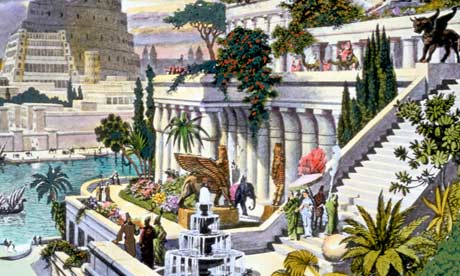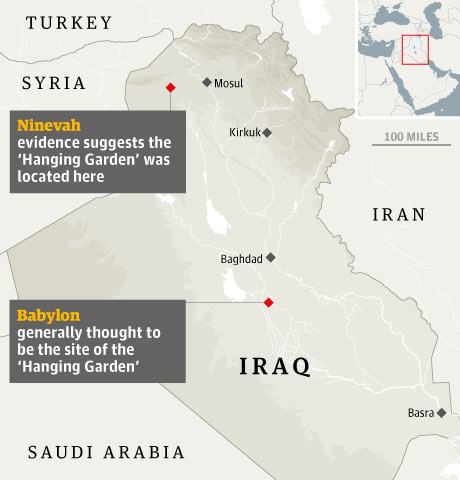Babylon's hanging garden: ancient scripts give clue to missing wonder
A British academic has gathered evidence suggesting garden was created at Nineveh, 300 miles from Babylon

Stephanie Dalley pieced together ancient texts to reveal a garden that recreated a mountain landscape. Photograph: Bettmann/Corbis
The whereabouts of one of the seven wonders of the ancient world – the fabled Hanging Garden of Babylon – has been one of the great mysteries from antiquity. The inability of archaeologists to find traces of it among Babylon's ancient remains led some even to doubt its existence.
Now a British academic has amassed a wealth of textual evidence to show that the garden was instead created at Nineveh, 300 miles from Babylon, in the early 7th century BC.
After 18 years of study, Stephanie Dalley of Oxford University has concluded that the garden was built by the Assyrians in the north of Mesopotamia – in modern Iraq – rather than by their great enemies the Babylonians in the south.
She believes her research shows that the feat of engineering and artistry was achieved by the Assyrian king, Sennacherib, rather than the Babylonian king, Nebuchadnezzar.
The evidence presented by Dalley, an expert in ancient Middle Eastern languages, emerged from deciphering Babylonian and Assyrian cuneiform scripts and reinterpreting later Greek and Roman texts. They included a 7th-century BC Assyrian inscription that, she discovered, had been mistranslated in the 1920s, reducing passages to "absolute nonsense".
She was astonished to find Sennacherib's own description of an "unrivalled palace" and a "wonder for all peoples". He describes the marvel of a water-raising screw made using a new method of casting bronze – and predating the invention of Archimedes' screw by some four centuries.
Dalley said this was part of a complex system of canals, dams and aqueducts to bring mountain water from streams 50 miles away to the citadel of Nineveh and the hanging garden. The script records water being drawn up "all day".

Recent excavations have found traces of aqueducts. One near Nineveh was so vast that Dalley said its remains looked like a stretch of motorway from the air, and it bore a crucial inscription: "Sennacherib king of the world … Over a great distance I had a watercourse directed to the environs of Nineveh …"
Having first broached her theory in 1992, Dalley is now presenting a mass of evidence in a book, The Mystery of the Hanging Garden of Babylon, which Oxford University Press publishes on 23 May. She expects to divide academic opinion, but the evidence convinces her that Sennacherib's garden fulfils the criteria for a wonder of the world – "magnificent in conception, spectacular in engineering, and brilliant in artistry".
Dalley said: "That the Hanging Garden was built in Babylon by Nebuchadnezzar the Great is a fact learned at school and … 'verified' in encyclopaedias … To challenge such a universally accepted truth might seem the height of arrogance, revisionist scholarship ... But Assyriology is a relatively recent discipline … Facts that once seemed secure become redundant."
Sennacherib's palace, with steps of semi-precious stone and an entrance guarded by colossal copper lions, was magnificent. Dalley pieced together ancient texts to reveal a garden that recreated a mountain landscape. It boasted terraces, pillared walkways, exotic plants and trees, and rippling streams.
The seven wonders appear in classical texts written centuries after the garden was created, but the 1st-century historian Josephus was the only author to name Nebuchadnezzar as creator of the Hanging Garden, Dalley said. She found extensive confusion over names and places in ancient texts, including the Book of Judith, muddling the two kings.
Little of Nineveh – near present-day Mosul – has so far been explored, because it has been judged too dangerous until now to conduct excavat
http://www.guardian.co.uk/science/2013/may/05/babylon-hanging-garden-wonder-nineveh
Dr. EMAD HANI ISMAEEL
Ph.D. in Technologies for the Exploitation
of the Cultural Heritage .
Senior Lecturer in the Dept. of Architecture
College of Engineering , University of Mosul
Mosul - Iraq .
E-mail: emadhanee@yahoo.com
Web Site: http://sites.google.com/site/emadhanee/
Tel : +964 (0)770 164 93 74
تعليقات
إرسال تعليق